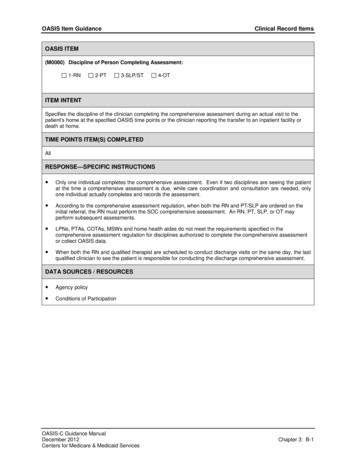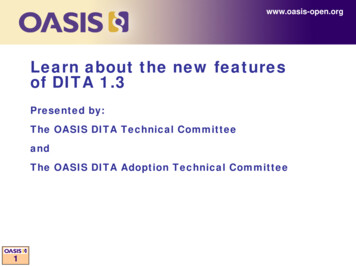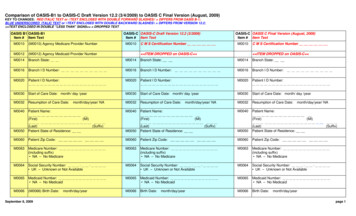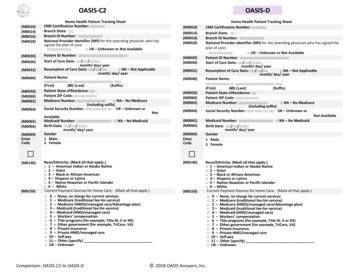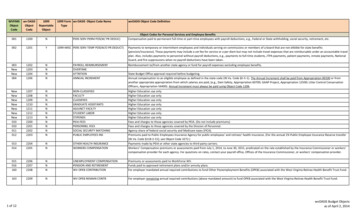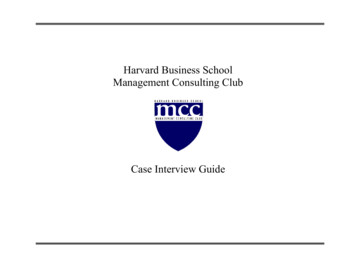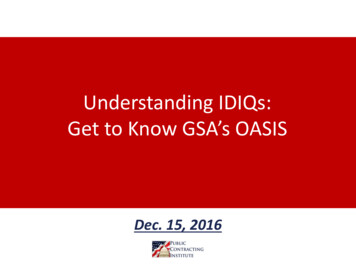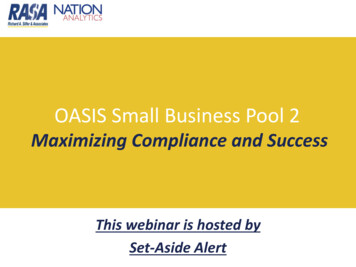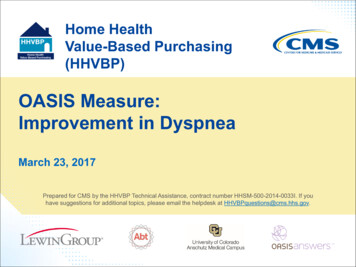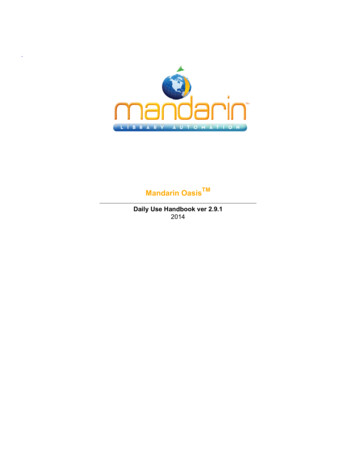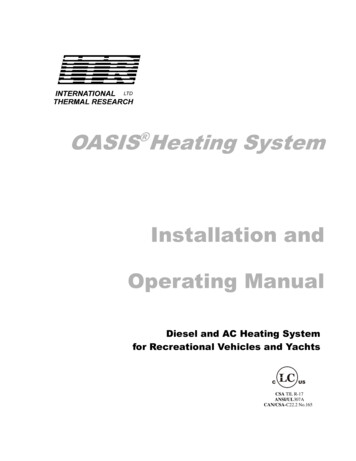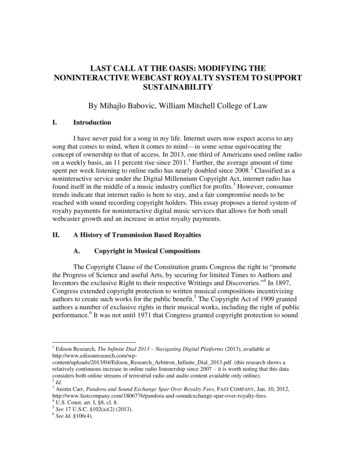
Transcription
LAST CALL AT THE OASIS: MODIFYING THENONINTERACTIVE WEBCAST ROYALTY SYSTEM TO SUPPORTSUSTAINABILITYBy Mihajlo Babovic, William Mitchell College of LawI.IntroductionI have never paid for a song in my life. Internet users now expect access to anysong that comes to mind, when it comes to mind—in some sense equivocating theconcept of ownership to that of access. In 2013, one third of Americans used online radioon a weekly basis, an 11 percent rise since 2011.1 Further, the average amount of timespent per week listening to online radio has nearly doubled since 2008.2 Classified as anoninteractive service under the Digital Millennium Copyright Act, internet radio hasfound itself in the middle of a music industry conflict for profits.3 However, consumertrends indicate that internet radio is here to stay, and a fair compromise needs to bereached with sound recording copyright holders. This essay proposes a tiered system ofroyalty payments for noninteractive digital music services that allows for both smallwebcaster growth and an increase in artist royalty payments.II.A History of Transmission Based RoyaltiesA.Copyright in Musical CompositionsThe Copyright Clause of the Constitution grants Congress the right to “promotethe Progress of Science and useful Arts, by securing for limited Times to Authors andInventors the exclusive Right to their respective Writings and Discoveries.”4 In 1897,Congress extended copyright protection to written musical compositions incentivizingauthors to create such works for the public benefit.5 The Copyright Act of 1909 grantedauthors a number of exclusive rights in their musical works, including the right of publicperformance.6 It was not until 1971 that Congress granted copyright protection to sound1Edison Research, The Infinite Dial 2013 – Navigating Digital Platforms (2013), available 2013/04/Edison Research Arbitron Infinite Dial 2013.pdf. (this research shows arelatively continuous increase in online radio listenership since 2007 – it is worth noting that this dataconsiders both online streams of terrestrial radio and audio content available only online).2Id.3Austin Carr, Pandora and Sound Exchange Spar Over Royalty Fees, FAST COMPANY, Jan. 10, d-soundexchange-spar-over-royalty-fees.4U.S. Const. art. I, §8, cl. 8.5See 17 U.S.C. §102(a)(2) (2013).6See Id. §106(4).
recordings of musical compositions.7 Notably, the Copyright Act does not include anexclusive right to the public performance of sound recordings.8 Thus, while radiobroadcasters have to pay performance royalties to songwriters as owners of musicalcomposition copyrights, these broadcasters have never had to pay royalties for use of theactual sound recording.9B.The Digital Audio Transmission RightThe first instances of Internet radio occurred when terrestrial radio stations beganto stream content online in 1994.10 Only a year later, Congress passed the DigitalPerformance Right in Sound Recordings Act (“DPRSRA”),11 granting copyright holdersthe exclusive right “to perform the copyrighted work publicly by means of a digital audiotransmission.”12 The Senate Committee on the Judiciary enacted these changes in order toprotect those who “depend upon revenues derived from traditional record sales,”expressing a distinct concern with the development of services that allow a listener torequest and hear a specific song at any time.13 This goal was achieved by the creation of athree-tier system14 dividing streaming services based on the determination that they are:(1) interactive,15 subscription services, (2) noninteractive services, or (3) nonsubscription,noninteractive transmissions.16 Depending on the classification a particular servicereceives, a different mechanism applies for determining royalties.17 Under thisframework, copyright holders were given protection for the use of their work oninteractive and digital subscription services but not when their work was transmitted by7See Sound Recording Act of 1971, Pub. L. No. 92-140, 85 Stat. 391 (1971) (establishing the right “[t]oreproduce and distribute to the public sound recording[s].”).8Id.9Kaitlin M. Pals, Facing the Music: Webcasting, Interactivity, and a Sensible Statutory Royalty Scheme forSound Recording Transmissions, 36 J. CORP. L. 677, 679 (2011).10Tyler Hardman, Webcasting and Interactivity: Problems and Solutions, 17 B.U. J. SCI. & TECH. L. 290,303 (2011).11Digital Performance Right in Sound Recording Act of 1995, Pub. L. No. 104-39, 109 Stat. 336. (codifiedas amended in scattered sections of 17).1217 U.S.C. §106(6) (2013); Digital Performance Right in Sound Recordings Act, §2.13S. Rep. No. 104-128, at 14 (1995).14Bonneville Intern. Corp. v. Peters, 153 F. Supp. 2d 763, 767 (E.D. Penn. 2001) (explaining that thecategorization of digital transmissions was based “on their likelihood to affect record sales.”).1517 U.S.C. §114(e)(1); Digital Performance Right in Sound Recordings Act, §3. (According to theDPRSRA, an “interactive” service is one that enables a member of the public to receive, on request, atransmission of a particular sound recording chosen by or on behalf of the recipient. The ability ofindividuals to request that particular sound recordings be performed for reception by the public at largedoes not make a service interactive.).16See H.R. Rep. No. 104-274, at 14 (1995) (Services within this tier were altogether exempt from theDPRSRA, and included radio broadcasts that were available free of charge.).17See Neil S. Tyler, Music Piracy and Diminishing Revenues: How Compulsory Licensing for InteractiveWebcasters Can Lead the Recording Industry Back to Prominence, 161 U. PA. L. REV. 2101, 2120 (2013)(The first category requires authorization from and payment to the copyright owner for each offered soundrecording. The second category subjects services to a compulsory license, and the third category isexempted from paying sound recording copyright owner for use of the sound recording.).
terrestrial or Internet radio stations that were non-interactive and available without asubscription.18Recognizing the inadequacy of protection provided by the DPRSRA, Congressfurther amended these licensing regulations with the passage of the Digital MillenniumCopyright Act (“DMCA”) in 1998.19 Further limiting royalty payment exceptions to only“nonsubscription broadcast transmission[s],”20 these changes meant that webcasts nowhad to pay performance royalties21—including transmissions by terrestrial radio stationsvia the Internet.22 Thus, while interactive services must negotiate royalty rates with thesound recording copyright holders, noninteractive services simply owe a congressionallyestablished compulsory license provided that they adhere to a number of requirements.23An important determination to be made for an internet radio service, then, iswhether or not it is “interactive”—a central issue in Arista Records, LLC v. LaunchMedia, Inc.24 LAUNCHcast was an internet radio website that allowed users to create“stations” that play music within a particular genre or similar to a particular artist or songthat the user selects.25 It was alleged that that this use was “interactive” and thus aninfringement because Launch Media paid the statutory royalties available tononinteractive services.26 In making its determination, the court focused on whether thewebcast provided users with such predictability or control that it “offered listeners theability to select music in such a way that they would forego purchasing records.”27Ultimately, it was concluded that LAUNCHcast was not an interactive service,28 meaningthat it and similar services were subject to statutory royalties instead of having tonegotiate royalties with copyright holders directly.29C.Compulsory Licensing for Noninteractive ServicesMore recently, however, the primary conflict between webcasters and copyrightholders has not been whether a compulsory license applies, but rather what the18Mary Ann Lane, “Interactive Services” and the Future of Internet Radio Broadcasts, 62 ALA. L. REV.459, 464 (2011) (“This arrangement reflected the idea that traditional radio broadcasting promotes interestin individual music artists and helps record sales, but failed to address the rapidly growing area of Internetradio and webcasting.”).19Digital Millennium Copyright Act, Pub. L. No. 105-304, 112 Stat. 2860 (1998) (codified in scatteredsections of 17 U.S.C.).2017 U.S.C. 114(d)(1)(A) (2013); Digital Millennium Copyright Act, §405.21Emily D. Harwood, Staying Afloat in the Internet Stream: How to Keep Web Radio from Drowning inDigital Copyright Royalties, 56 FED. COMM. L.J. 673, 681 (2004) (“nonbroadcast transmissions previouslyexempted from the DPRSRA were now subject to royalty requirements.”).22See generally Bonneville, 153 F. Supp. 2d at 490.23See generally Martha F. Phelps, Complying with Requirements for a Statutory License in SoundRecordings Under the Digital Millennium Act of 1998, BOSTON B.J., Mar.-Apr. 2001, at 6, 20-22.(outlining the various requirements listed in 17 U.S.C. §114(d)(2).).24Arista Records, LLC. v. Launch Media, Inc., 578 F.3d 148 (2d Cir. 2009).25Id. at 150.26Id.27Id. at 157.28Id. at 164.29Id. (The court noted that the interactivity determination for internet audio services is a fact intensivedetermination to be made on a case-by-case basis).
congressionally prescribed royalty rate should be.30 Both the DPRSRA and DMCAincluded a voluntary negotiation period between copyright holders and webcasters todetermine the compulsory license, and granted arbitration power to a CopyrightArbitration Royalty Panel (“CARP”) in the event that an agreement could not bereached.31 After the parties were unable to settle on a statutory license the CARP releasedroyalty rate determinations requiring webcasters to pay royalties on a per-performancebasis.32 This royalty rate, however, was necessarily unsustainable by smaller webcastersas it was based solely on the voluntary transaction between Yahoo! and the RIAA.33Realizing the dramatic affect such rates could have on their livelihood, small webcastersappealed to Congress for help. Assistance came in the form of the Small WebcasterSettlement Act of 2002, allowing for additional negotiation time, and ultimately resultingin the short-term establishment of royalty rates based on the webcasters’ gross revenue.34This revenue based royalty payment system expired in 2005, and as thesenegotiated terms came to an end, “the brawl began anew.”35 Once again the CopyrightRoyalty Board (the CARP’s successor) set per-performance royalty rates that threatenedthe existence of webcasters both large and small.36 Congress, as before, increased thenegotiation time for webcasters and copyright owners by passing the Small WebcasterSettlement Act of 2008.37 A settlement was reached, establishing the royalty rates thatapply through 2015.38D.The Internet Radio Fairness ActUnder the tripartite structure of the DMCA, it would seem advantageous for anInternet radio provider to qualify for the noninteractive compulsory license and thusavoid the high costs of negotiating directly with sound recording copyright owners.39However, even Pandora, one of the most successful internet radio services to date, haspaid over fifty percent of its revenue to royalties for the past three years.40 This seemingly30See Tyler, supra note 17, at 2127. (“[T]he establishment of the current compulsory license fornoninteractive webcasters may have been the longest and most bitterly battled of all the compulsorylicenses established under the Copyright Act.”).31Brian Day, The Super Brawl: The History and Future of the Sound Recording Performance Right, 16MICH. TELECOMM. & TECH. L. REV. 179, 188 (2009).32Id.33See Tyler supra note 17, at 2129. (smaller webcasters did not have the same business structure,resources, or capabilities as Yahoo! and thus could not pay the same royalty rates while turning a profit.)34Notification of Agreement Under the Small Webcaster Settlement Act of 2002, 67 Fed. Reg. 78,51078,511 (Dec. 24, 2002). (stating “the royalty rate shall be 10 percent of the eligible small webcaster's first 250,000 in gross revenues and 12 percent of any gross revenues in excess of 250,000 during theapplicable year, or 7 percent of the webcaster's expenses during the applicable year, whichever is greater.”)35See Day, supra note 31, at 189.36Amy Duvall, Royalty Rate Setting for Webcasters: A Royal(ty) Mess, 15 MICH. TELECOMM. & TECH. L.REV. 267, 280 (2008).37The Webcaster Settlement Act of 2009, Pub. L. No. 111-36, 123 Stat. 1926 (codified as amended inscattered sections of 17 U.S.C.).38See Notification of Agreements Under the Webcaster Settlement Act of 2009, 74 Fed. Reg. 34,796 (July17, 2009) (settlement between SoundExchange and the commercial webcasters).39See Tyler, supra note 17, at 2122.40Jasmine A. Braxton, Lost in Translation: The Obstacles of Streaming Digital Media and the Future ofTransnational Licensing, 36 HASTINGS COMM. & ENT. L.J. 193, 200 (2014) (“Pandora paid out royalties of
unsustainable business model led to the introduction of the Internet Radio Fairness Act(“IRFA”) into the House of Representatives in September 2012. The IRFA aimed tochange how noninteractive services pay royalties, moving from the “willing buyer,willing seller” model to a percentage of the company’s income.41 Opponents of the bill(comprised mostly of artists and labels) argued that the royalty rates are already too lowand that Pandora is simply employing an ineffective business model.42 Unsurprisingly, noagreement was reached by the end of the 112th Congress; in the words of the RecordingAcademy President and CEO Neil Portnow, the “IRFA is officially defeated.”43E.Free Market Royalty ActIntroduced to the House of Representatives last September, the Free MarketRoyalty Act44 (“FMRA”) seeks to eliminate the distinction between digital and terrestrialtransmissions of sound recordings and remove the compulsory licensing system currentlyin place for royalties.45 The passage of this bill would end the longstanding agreementbetween agreement between terrestrial radio and the record industry.46 Supporters of thebill claim that the terrestrial radio exception to the sound recording royalty is unfair whilebroadcasters claim that many stations could not pay the royalties, or would switch to aspoken-word format in order to avoid the increased costs.47 Clear Channel, a largeterrestrial radio conglomerate, has made private agreements to pay a performance royaltypayment with several record labels.48 However, given the size of Clear Channel thiswillingness is likely not representative of terrestrial broadcasters generally. While thismethod would certainly provide sound recording copyright holders a short-term stream ofincome—as 82 percent of Americans listen to terrestrial radio weekly49—thesustainability of such royalties seems questionable at best. This act also assumes thatwebcasters will successfully negotiate with the copyright owners, an assumption that hasgenerally proven untrue for the past decade. Given the history of limited compromisebetween the radio industry and sound recording copyright owners, the conclusion that afair settlement will take place seems speculative at best.sixty percent, fifty percent, and fifty-four percent of its revenue in fiscal years 2010, 2011, and 2012respectively.).41Steve Knopper, Pandora Clashes With Musicians Over Song Payments, ROLLING STONE, Dec. 3, 03.(noting that satellite radio companies pay 7.5 percent of their revenue in royalties, and cable-televisionmusic channels pay 15 percent.).42Carr, supra note 3.43Glenn Peoples, Internet Radio Fairness Act Slips Into Hibernation, BILLBOARD, Jan. 3, nation.44Free Market Royalty Act, H.R. 3219, 113th Cong. (2013).45Chris Castle, Guest Post: Meet the Free Market Royalty Act, an Elegant Solution to Some ComplexIssues, BILLBOARD, Oct. 1, 2013, et-royalty-act-an.46See Braxton, supra note 40, at 196. (“The recording industry recognized a mutual benefit in radiobroadcasts; their music would receive free advertising and lead consumers to purchase music, while radiobroadcasters would gain a listening audience.”).47Nate Rau, Congress to Consider Radio Royalties for Artists, THE LEAF CHRONICLE, Sept. 17, cle/2829099.48Id.49See Edison Research, supra note 1.
III.Current Trends of Internet RadioAs is evident, the compulsory licensing rates currently in place for noninteractiveinternet radio services are not satisfactory for any party involved. Further, the applicationof a per-play royalty payment has received heavy criticism for being prohibitivelyexpensive.50 While revenue based models have been proposed as a solution to this issue,such royalty payments allow small webcasters with little revenue to use adisproportionate amount of intellectual property in regard to the compensation offered.51A compromise, then, must lie in the balancing of recording industry interests and internetradio service interests.The music industry’s resistance to lowering royalty rates for internet radio issomewhat surprising considering the affect such services have on music piracy.According to the NPD Group’s 2012 study, nearly half of the 40 percent of consumerswho had stopped pirating music in the last year cited free, legal music streaming servicesas their reason for doing so.52 Looking to other markets, studies have linked Spotify (aninteractive streaming music service) to a 25 percent decrease in music piracy since2009.53 Similarly, in the film industry it has been suggested that increasing Netflix (atelevision/movie streaming service) subscriptions corresponds with lowered film piracyrates.54 While little data is available to show a direct link to the emergence of free orinexpensive legal media and lowered piracy rates, it seems abundantly clear that access toinexpensive alternatives has led to fewer incidents of online piracy.55Apart from the subsidiary benefit of curbing music piracy, music streaming isbeginning to show itself as a viable long-term income stream for the music industry.56SoundExchange, the nonprofit organization responsible for collecting and distributingdigital performance royalties, has posted increased annual payouts for the past decade,and shows no signs of slowing.57 Late in 2013, Apple and Google launched new clients50Ira Hoffman, Pseudo-Interactivity: An Appropriate Rate Scheme for Customizable Internet RadioServices, 32 CARDOZO L. REV. 1515, 1522 (2011).51Duvall, supra note 36, at 273. (a revenue based model would allow for extensive use of intellectualproperty with little or no compensation is contrary to Congress’s intention in enacting the DMCA).52Press Release, The NPD Group: Music File Sharing Declined Significantly in 2012, NPD GROUP, Feb.26, 2012, ignificantly-in-2012/. (noting that the increased use of legal and licensed streaming services hasproven to be an alternative to consumers who previously used music piracy to obtain music.).53Rebecca Guerrero, Internet Radio Decreases Amount of Illegal Music Downloads, THE PROSPECTOR,May 17, 2013, 17#.UseydmRDt43.54George Wong, Netflix is Doing Its Job to Reduce Piracy in North America, UBERGIZMO, May 17, ce-piracy-north-america/. (it is worth noting that this datais correlative at best, as tracking piracy rates with Netflix membership seems
LAST CALL AT THE OASIS: MODIFYING THE NONINTERACTIVE WEBCAST ROYALTY SYSTEM TO SUPPORT SUSTAINABILITY By Mihajlo Babovic, William Mitchell College of Law . exempted from paying sound recording copyright owner for use of the sound recording.). terrestrial or Internet radio s
